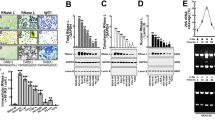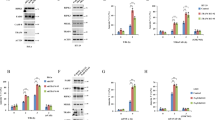Abstract
Tumor necrosis factor (TNF)-related apoptosis-inducing ligand (TRAIL), a member of the TNF superfamily, induces apoptosis in a variety of cancer cells with little or no effect on normal cells. Human hepatoma cells, however, are resistant to TRAIL-induced apoptosis. Since interferon-α (IFN-α) is capable of enhancing TNF-α-induced apoptosis in certain cancer cells, we evaluated the effect of IFN-α on TRAIL-induced apoptosis of human hepatoma cells. IFN-α pretreatment enhanced TRAIL-induced apoptosis of HuH-7 and Hep3B cells, in which IFN-α upregulated the expression of DR5, a death receptor of TRAIL, and downregulated the expression of survivin, which has an antiapoptotic function. In contrast, IFN-α did not enhance TRAIL-induced apoptosis of HepG2 cells, in which expression of DR5 and survivin was not affected by IFN-α. On the other hand, TRAIL activated NF-κB composed of RelA-p50 heterodimer, a key transcription factor regulating cell survival, in HuH-7 and HepG2 cells. However, IFN-α pretreatment repressed the TRAIL-mediated activation of NF-κB and decreased its transcriptional activity in HuH-7 but not in HepG2 cells. Moreover, IFN-α pretreatment clearly augmented TRAIL-mediated caspase-8 activation in HuH-7 cells. Our results suggest that IFN-α could sensitize certain human hepatoma cells to TRAIL-induced apoptosis by stimulating its death signaling and by repressing the survival function in these cells.
This is a preview of subscription content, access via your institution
Access options
Subscribe to this journal
Receive 50 print issues and online access
$259.00 per year
only $5.18 per issue
Buy this article
- Purchase on Springer Link
- Instant access to full article PDF
Prices may be subject to local taxes which are calculated during checkout










Similar content being viewed by others
Abbreviations
- EMSA:
-
electrophoretic mobility shift assay
- FADD:
-
Fas-associated death domain
- FLIP:
-
FLICE-inhibitory protein
- IAP:
-
inhibitor of apoptosis
- IETD-pNA:
-
N-acetyl-Ile-Glu-Thr-Asp-p-nitroaniline
- IFN-α:
-
interferon-α
- TNF:
-
tumor necrosis factor
- TRAIL:
-
tumor necrosis factor-related apoptosis-inducing ligand
- XIAP:
-
X-chromose–linked IAP
References
Ashkenazi A, Pai RC, Fong S, Leung S, Lawrence DA, Marsters SA, Blackie C, Chang L, McMurtrey AE, Hebert A, DeForge L, Koumenis IL, Lewis D, Harris L, Bussiere J, Koeppen H, Shahrokh Z and Schwall RH . (1999). J. Clin. Invest., 104, 155–162.
Barkett M and Gilmore TD . (1999). Oncogene, 18, 6910–6924.
Belka C, Schmid B, Marini P, Durand E, Rudner J, Faltin H, Bamberg M, Schulze-Osthoff K and Budach W . (2001). Oncogene, 20, 2190–2196.
Chawla-Sarkar M, Leaman DW and Borden EC . (2001). Clin. Cancer Res., 7, 1821–1831.
Chen C, Edelstein LC and Gelinas C . (2000). Mol. Cell Biol., 20, 2687–2695.
Chen Q, Gong B, Mahmoud-Ahmed AS, Zhou A, Hsi ED, Hussein M and Almasan A . (2001). Blood, 98, 2183–2192.
Chinnaiyan AM, Prasad U, Shankar S, Hamstra DA, Shanaiah M, Chenevert TL, Ross BD and Rehemtulla A . (2000). Proc. Natl. Acad. Sci. USA, 97, 1754–1759.
Degli-Esposti MA, Dougall WC, Smolak PJ, Waugh JY, Smith CA and Goodwin RG . (1997a). Immunity, 7, 813–820.
Degli-Esposti MA, Smolak PJ, Walczak H, Waugh J, Huang CP, DuBose RF, Goodwin RG and Smith CA . (1997b). J. Exp. Med., 186, 1165–1170.
Di Pietro R, Secchiero P, Rana R, Gibellini D, Visani G, Bemis K, Zamai L, Miscia S and Zauli G . (2001). Blood, 97, 2596–2603.
Emery JG, McDonnell P, Burke MB, Deen KC, Lyn S, Silverman C, Dul E, Appelbaum ER, Eichman C, DiPrinzio R, Dodds RA, James IE, Rosenberg M, Lee JC and Young PR . (1998). J. Biol. Chem., 273, 14363–14367.
Fanger NA, Maliszewski CR, Schooley K and Griffith TS . (1999). J. Exp. Med., 190, 1155–1164.
Gibson SB, Oyer R, Spalding AC, Anderson SM and Johnson GL . (2000). Mol. Cell Biol., 20, 205–212.
Griffith TS, Fialkov JM, Scott DL, Azuhata T, Williams RD, Wall NR, Altieri DC and Sandler AD . (2002). Cancer Res., 62, 3093–3099.
Grossman D, Kim PJ, Schechner JS and Altieri DC . (2001). Proc. Natl. Acad. Sci. USA, 98, 635–640.
Gutterman JU . (1994). Proc. Natl. Acad. Sci. USA, 91, 1198–1205.
Ichikawa T, Nakao K, Nakata K, Hamasaki K, Takeda Y, Kajiya Y, Higashi S, Ohkubo K, Kato Y, Ishii N and Eguchi K . (2001). Biochem. Biophys. Res. Commun., 280, 933–939.
Inan MS, Rasoulpour RJ, Yin L, Hubbard AK, Rosenberg DW and Giardina C . (2000). Gastroenterology, 118, 724–734.
Ito T, Shiraki K, Sugimoto K, Yamanaka T, Fujikawa K, Ito M, Takase K, Moriyama M, Kawano H, Hayashida M, Nakano T and Suzuki A . (2000). Hepatology, 31, 1080–1085.
Jo M, Kim TH, Seol DW, Esplen JE, Dorko K, Billiar TR and Strom SC . (2000). Nat. Med., 6, 564–567.
Kayagaki N, Yamaguchi N, Nakayama M, Eto H, Okumura K and Yagita H . (1999). J. Exp. Med., 189, 1451–1460.
Kischkel FC, Lawrence DA, Chuntharapai A, Schow P, Kim KJ and Ashkenazi A . (2000). Immunity, 12, 611–620.
Kobayashi K, Hatano M, Otaki M, Ogasawara T and Tokuhisa T . (1999). Proc. Natl. Acad. Sci. USA, 96, 1457–1462.
Lacour S, Hammann A, Wotawa A, Corcos L, Solary E and Dimanche-Boitrel MT . (2001). Cancer Res., 61, 1645–1651.
Lawrence D, Shahrokh Z, Marsters S, Achilles K, Shih D, Mounho B, Hillan K, Totpal K, DeForge L, Schow P, Hooley J, Sherwood S, Pai R, Leung S, Khan L, Gliniak B, Bussiere J, Smith CA, Strom SS, Kelley S, Fox JA, Thomas D and Ashkenazi A . (2001). Nat. Med., 7, 383–385.
Li F, Ambrosini G, Chu EY, Plescia J, Tognin S, Marchisio PC and Altieri DC . (1998). Nature, 396, 580–584.
Manna SK, Mukhopadhyay A and Aggarwal BB . (2000). J. Immunol., 165, 4927–4934.
Nagane M, Pan G, Weddle JJ, Dixit VM, Cavenee WK and Huang HJ . (2000). Cancer Res., 60, 847–853.
Nakabayashi H, Taketa K, Yamane T, Miyazaki M, Miyano K and Sato J . (1984). Gann, 75, 151–158.
Nakao K, Nakata K, Yamashita M, Tamada Y, Hamasaki K, Ishikawa H, Kato Y, Eguchi K and Ishii N . (1999). J. Biol. Chem., 274, 28075–28078
Nimmanapalli R, Perkins CL, Orlando M, O'Bryan E, Nguyen D and Bhalla KN . (2001). Cancer Res., 61, 759–763.
Olie RA, Simoes-Wust AP, Baumann B, Leech SH, Fabbro D, Stahel RA and Zangemeister-Wittke U . (2000). Cancer Res., 60, 2805–2809.
Pan G, O'Rourke K, Chinnaiyan AM, Gentz R, Ebner R, Ni J and Dixit VM . (1997). Science, 276, 111–113.
Ravi R, Bedi GC, Engstrom LW, Zeng Q, Mookerjee B, Gelinas C, Fuchs EJ and Bedi A . (2001). Nat. Cell Biol., 3, 409–416.
Schneider P, Thome M, Burns K, Bodmer JL, Hofmann K, Kataoka T, Holler N and Tschopp J . (1997). Immunity, 7, 831–836.
Sheridan JP, Marsters SA, Pitti RM, Gurney A, Skubatch M, Baldwin D, Ramakrishnan L, Gray CL, Baker K, Wood WI, Goddard AD, Godowski P and Ashkenazi A . (1997). Science, 277, 818–821.
Suk K, Kim YH, Chang I, Kim JY, Choi YH, Lee KY and Lee MS . (2001). FEBS Lett., 495, 66–70.
Sun SY, Yue P, Hong WK and Lotan R . (2000). Cancer Res., 60, 7149–7155.
Tamm I, Wang Y, Sausville E, Scudiero DA, Vigna N, Oltersdorf T and Reed JC . (1998). Cancer Res., 58, 5315–5320.
Toomey NL, Deyev VV, Wood C, Boise LH, Scott D, Liu LH, Cabral L, Podack ER, Barber GN and Harrington Jr WJ . (2001). Oncogene, 20, 7029–7040.
Walczak H, Miller RE, Ariail K, Gliniak B, Griffith TS, Kubin M, Chin W, Jones J, Woodward A, Le T, Smith C, Smolak P, Goodwin RG, Rauch CT, Schuh JC and Lynch DH . (1999). Nat. Med., 5, 157–163.
Wang CY, Mayo MW, Korneluk RG, Goeddel DV and Baldwin Jr AS . (1998). Science, 281, 1680–1683.
Wen Y, Yan DH, Spohn B, Deng J, Lin SY and Hung MC . (2000). Cancer Res., 60, 42–46.
Yamanaka T, Shiraki K, Sugimoto K, Ito T, Fujikawa K, Ito M, Takase K, Moriyama M, Nakano T and Suzuki A . (2000). Hepatology, 32, 482–490.
Zhou Q, Fukushima P, DeGraff W, Mitchell JB, Stetler Stevenson M, Ashkenazi A and Steeg PS . (2000). Cancer Res., 60, 2611–2615.
Acknowledgements
We thank Prof. T Tokuhisa (Department of Developmental Genetics, Chiba University, Japan) for generously providing pCR2FL.
Author information
Authors and Affiliations
Corresponding author
Rights and permissions
About this article
Cite this article
Shigeno, M., Nakao, K., Ichikawa, T. et al. Interferon-α sensitizes human hepatoma cells to TRAIL-induced apoptosis through DR5 upregulation and NF-κB inactivation. Oncogene 22, 1653–1662 (2003). https://doi.org/10.1038/sj.onc.1206139
Received:
Revised:
Accepted:
Published:
Issue Date:
DOI: https://doi.org/10.1038/sj.onc.1206139
Keywords
This article is cited by
-
CIB1 depletion with docetaxel or TRAIL enhances triple-negative breast cancer cell death
Cancer Cell International (2019)
-
Type I interferons in infectious disease
Nature Reviews Immunology (2015)
-
Hepatocellular carcinoma: targeting of oncogenic signaling networks in TRAIL resistant cancer cells
Molecular Biology Reports (2014)
-
Interferon-α sensitizes HBx-expressing hepatocarcinoma cells to chemotherapeutic drugs through inhibition of HBx-mediated NF-κB activation
Virology Journal (2013)
-
Sub-Toxic Dose of Apigenin Sensitizes HepG2 Cells to TRAIL through ERK-Dependent Up-Regulation of TRAIL Receptor DR5
Molecules and Cells (2013)



